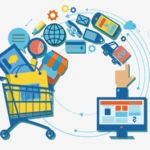From Concept to Launch: How SaaS Application Development Services Build Scalable Products
November 14, 2025 | 0 Comments
info@trickywebsolutions.com |
+1-225-276-2741
 USA
USA IN
IN
 SG
SG
 PT
PT
With the evolving economy, e-tailers are also looking for innovative solutions that can help them grow. If you are an online retailer wanting to transform your solutions to meet evolving customers’ needs, you must have come across the term headless commerce. So, what is headless commerce? Headless commerce is a fast-emerging and one of the most significant e-commerce trends in 2025. There are a number of benefits of implementing headless commerce, which include drastic improvements in the performance of sites and unparalleled flexibility to make changes quickly.
Headless commerce provides brands full control while allowing developers to build customized e-commerce websites with their technology of choice. But making the switch to a headless architecture is not as easy as it’s made out to be, and there are numerous reasons why it might not be the best option for all merchants. In this guide, we will understand what is headless commerce, the several benefits of headless ecommerce, and headless e-commerce architecture.
Before making your e-commerce company headless, it is essential to know the basics of headless commerce. Having the knowledge of what is headless commerce, how it is different from conventional e-commerce practice, and what advantages you can avail once you implement it can make your business more successful and provide a customized experience to your customers.
Headless commerce, as the name suggests, divides the presentation layer and business logic layer of the e-commerce websites, so that each can work independently. The presentation layer handles the user interface. The back end is the transactional engine, which operates transaction logic and basic features. This headless setup merges the flexibility of a content management system with the security and reliability of a cloud-based e-commerce platform. Headless commerce may be a perfect fit for companies that emphasize copywriting or branding, employ non-standard design structures, or work in B2B contexts.
Headless commerce architecture operates by exchanging interactions between the user interface and the core application layer. This interaction happens through application programming interface (API) calls that link the front end with back-end features.
APIs – serve as a connector linking the front end and back end, allowing the transfer of data requests and inputs.
Back end – contains the core logic behind business operations and user activities
Front end – serves as the presentation layer, typically visible to users, including content and user interface elements.
Data sources – consist of connected business systems used to manage and store various types of business information.
Here we have listed a few benefits of headless e-commerce architecture for our e-commerce business:
One of the major benefits of headless e-commerce architecture is it gives you full design control over your online retailing business, which perfectly reflects your brand vision. However, this isn’t usually the starting point for most businesses entering the e-commerce space.
Most have a monolithic installation, where the front-end presentation layer—typically composed of themes or templates—is closely coupled with the back-end systems. This is a great way to get a store off the ground and out to market quickly. As your brand develops and your online presence becomes more sophisticated, the necessity for increased customization arises to provide richer, more personalized experiences.
This is one of the key advantages of implementing headless commerce architecture. This enables you to have complete flexibility in customizing your front end as well as the back end of the e-commerce infrastructure without influencing any other part.
When people come to your website, you only have a couple of seconds to grab their attention before they are gone. WebsiteBuilderExpert says site speed can strongly affect a website’s performance:
By adopting a headless architecture, you can build pages that load more quickly on both desktop and mobile devices.
As your business grows, you are required to expand your features and functionalities across your online stores. If you are still stuck with conventional architecture, it could be hard to expand your particular functionality without affecting other components, as they are usually integrated with each other. But if you adopt this architecture, you can easily expand your functions effortlessly with your business needs, making this capability one of the major benefits of headless e-commerce.
While transitioning to a headless commerce architecture can come with initial investment and increased complexity, the long-term benefits—such as increased flexibility, better scalability, and superior user experience—tend to outweigh the initial and ongoing costs in the long run.
Decentralized architecture separates the responsibilities within the development process. Prior to headless commerce, conventional retailing platforms required developers to work across multiple layers at once, limiting front-end developers from using modern JavaScript frameworks of their choice.
Several brands have adopted headless e-commerce, including:
Nike is one of the headless ecommerce examples which employs this approach to provide an effortless experience on different platforms with Unified brand identity and live stock updates. They emphasized building a mobile-first experience with optimized visuals and call-to-actions for smaller screens. This helped them capture market share from rivals such as Adidas.
Another headless ecommerce example is Tesla, which applies headless commerce to tailor the shopping experience, enabling consumers to select materials and colors when designing their cars. Such adaptability carries over into offering quicker customer service, testing alternatives, and better refund and delivery procedures.
This women’s clothing retailer leverages a headless e-commerce architecture to customize experiences, especially for mobile. They aimed at designing mobile-optimized images and links, accomplishing customized front-end experiences with no back-end restrictions.
BBG offers over 4K products and serves customers in 25+ countries. It sells through more than 99+ different channels, including D2C websites, online marketplaces, and wholesale partners.
More than ten years after it started, TALLY WEiJL began expanding worldwide, opening over 50+ stores. In the years that followed, it became a major name in global fashion retail.
Recent Posts

From Concept to Launch: How SaaS Application Development Services Build Scalable Products
November 14, 2025 | 0 Comments

Agentic AI: The Rise of Autonomous Decision-Makers in a Human-Centric World
November 12, 2025 | 0 Comments

Empowering Growth: Cutting-Edge SaaS Application Development Solutions
November 10, 2025 | 0 Comments

Step into Web Design & Development: Creative Solutions That Elevate Your Presence
November 3, 2025 | 0 Comments

Supercharge Your eCommerce: Innovative Mobile App Development Solutions
October 31, 2025 | 0 Comments

Building the Future: Scalable & Agile Cloud Native App Development Solutions
October 30, 2025 | 0 Comments
Categories

We will zealously try to help you by providing technical support. We are open to inquiries or requests.
info@trickywebsolutions.com
1945 Brightside Drive, Baton Rouge, LA -70820
We are available for a friendly chat to discuss your business needs, no obligation.